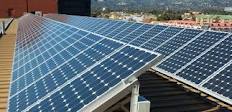The U.S. Department of Energy (DOE) released a report titled, "Solar Schools Assessment and Implementation Project: Financing Options for Solar Installations on K-12 Schools," detailing best practices for financing and installing photovoltaic (PV) systems on school buildings.
Produced under the SunShot initiative—a collaborative national effort to reduce the cost of solar energy 75% to make it cost competitive with other forms of energy by the end of the decade—the report released examines the successful development of Solar Master Plans (SMPs) for three California public school districts—Oakland, Berkeley, and West Contra Costa Unified School Districts. Installing solar energy systems on public schools can help school districts save money on their utility bills, reduce carbon emissions, support job creation, and provide students with opportunities to learn about clean energy.
The report examines the two primary types of ownership models used to obtain solar installations. This analysis can help school administrators across the country select the best option for deploying solar technologies in their school districts. The study supports DOE's SunShot initiative goal of addressing critical barriers, such as the availability of financing, to accelerate the integration of solar energy technologies across the United States.
The report focuses on financial options developed specifically for renewable energy and energy efficiency projects. Some highlights of the report include:
- An introduction to financing PV installations on schools
- A look at the direct-ownership option, which takes advantage of financing mechanisms such as general funds, bonds, construction funds, and grants
- A review of the third-party finance model, including power purchase agreements and energy services performance contracts.
In addition to comparing a range of financing options for PV installations, the report provides real-world examples of financing solar installations on K-12 schools and other public facilities. These examples may be used by school districts around the country to help them navigate the process of financing PV installations.
Click here to download the complete report. BD+C






